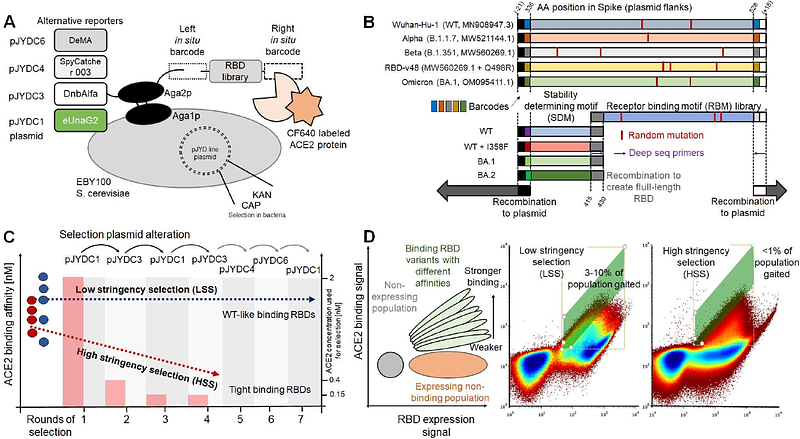In Vitro and Viral Evolution Convergence Reveal the Selective Pressures Driving Omicron Emergence

In Vitro and Viral Evolution Convergence Reveal the Selective Pressures Driving Omicron Emergence
Shoshany, A.; Tian, R.; Blanco, M. P.; Hruska, A.; Konar, A.; Baxova, K.; Zoler, E.; Mokrejs, M.; Schreiber, G.; Zahradnik, J.
AbstractIn vitro protein evolution provides powerful insights into the amino acid sequences that underlie key biological functions. Here, we used this approach to explore the evolutionary trajectories of the SARS-CoV-2 spike protein receptor-binding domain (RBD) constrained to engage the human ACE2 receptor, an essential first step in viral infection. Applying mild (LSS) or stringent (HSS) selection pressures starting from the ancestral Wuhan strain, we found that HSS, but not LSS rapidly converged on mutations characteristic of the Omicron variant. HSS resulted in fewer, but dominant, non-synonymous mutations mirroring Omicron mutations and its advanced sub-lineages. Conversely, LSS produced only some Omicron-like mutations at much lower frequencies and with incomplete representation. Notably, initiating evolution from Omicron itself resulted in high-fidelity maintenance of Omicron-defining mutations under both HSS and LSS conditions. This evolutionary pattern parallels global SARS-CoV-2 mutation trends as well as in silico simulations, emphasizing the critical role of receptor-binding constraints in shaping viral adaptation, which may be a frequent driver during zoonosis. Predominantly immune evasion associated mutations not selected in vitro. Our findings demonstrate the predictive capacity of in vitro evolution, suggesting Omicron\'s abrupt emergence resulted from rare, high-stringency selection, superimposed on a background of broader, milder pressures, with Omicron being the humanized SARS-CoV-2.